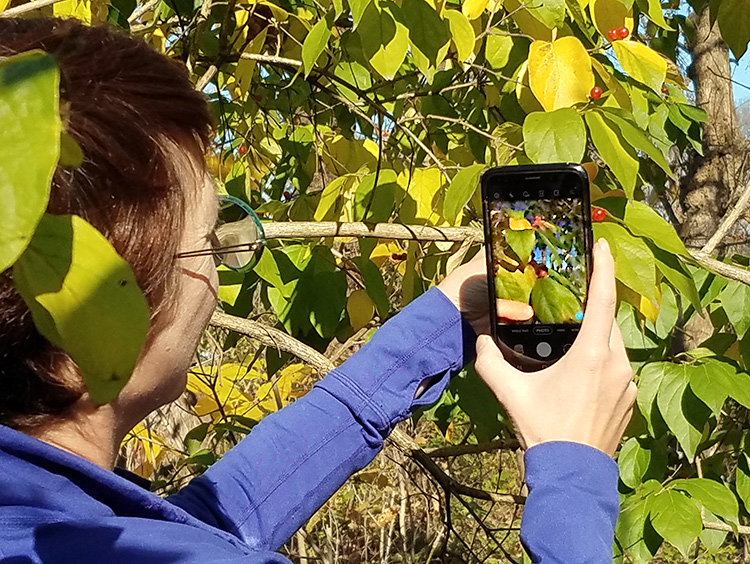As our ancestors, plants are more than just food, shelter, and oxygen producers. They have been intimately involved in shaping the human species. They arrived on earth millions of years before us and our bodies evolved to interact with them. Our eyes can detect the colors of their ripe fruits, our tongues can taste them, and our fingers are shaped to pluck, shuck, peel, weave, and plant them. Yet, I know so little about their ways of being in our shared world. With the hope of learning, I read many books. This led to a desire to have my own experiences with plants and to try to know them in ways that do not privilege human language. I began to observe them more closely; first by taking their portraits, then by sharing space and time with them in photographs and videos. I developed a regular practice I call “plant noticing”, which allows my eyes to be curious about them, my hands to be guided by the pleasure of their shapes and textures, and my cellphone to capture our time in the light together.
Try Plant Noticing

Why practice plant noticing?
- Increase your sense of belonging in the living world
- Enjoy pleasurable sensations
- Gain a sense of wonder and appreciation for life
- Exercise your perceptual skills and curiosity
- Cultivate gratitude
- Widen your circle of non-human friends

Tips for practicing plant noticing
- When you feel the urge to look at media on your phone, point it at a plant instead.
- See the plant through your camera and notice what you notice.
- Every day, take a minute to notice a plant
- Practice doing it without your phone camera
- Look for new plant friends indoors or outdoors
Bibliography
- Aloi, Giovanni, Caroline Picard, and Lucy Davis. Why Look at Plants?: The Botanical Emergence in Contemporary Art. Brill Rodopi, 2018.
- Brown, Adrienne M. Emergent Strategy: Shaping Change, Changing Worlds. Chico, CA: AK Press, 2017.
- Chamovitz, Daniel. What a Plant Knows: A Field Guide to the Senses. USA: Scientific American / Farrar, Straus and Giroux, 2017.
- Gagliano, Monica. Thus Spoke the Plant: A Remarkable Journey of Groundbreaking Scientific Discoveries and … Personal Encounters with Plants. Berkeley, CA: North Atlantic Books, 2018.
- Kimmerer, Robin Wall. Braiding Sweetgrass: Indigenous Wisdom, Scientific Knowledge and the Teachings of Plants. Milkweed Editions, 2015.
- Mancuso, Stefano, and Alessandra Viola. Brilliant green: the surprising history and science of plant intelligence. Washington: Island Press, 2015.
- Marder, Michael. Plant-Thinking: A Philosophy of Vegetal Life, Columbia University Press, 2013.
- Myers, Natasha. “How to Grow Liveable Worlds: Ten (Not-so-Easy) Steps for Life in the Planthroposcene – ABC Religion & Ethics.”
- Pollan, Michael. The Botany of Desire: A Plant’s Eye View of the World. New York, NY: Random House, 2008.
- Emergence Magazine. “The Ecology of Perception – David Abram.” Accessed August 16, 2020.
- Tsing, Anna Lowenhaupt, and Princeton University Press. The Mushroom at the End of the World: On the Possibility of Life in Capitalist Ruins. Princeton; Oxford: Princeton University Press, 2017.
- Wohlleben, Peter. HIDDEN LIFE OF TREES: What They Feel, How They Communicate. Greystone Books, 2018.
Thank you!
To Dr. Iris Meier, who shared with me her research showing that communication proteins used by plant cells are also used by human cells. To the Mountain Lake Biological Station ArtLab residency, where I began plant noticing and capturing many of the photos and videos that would much later appear in this project. To Candace Thompson and Alexis Nelson, for each sharing their ways of observing, befriending, and honorably foraging for urban plants. To Norah Zuniga-Shaw for teaching me to “notice-what-you-notice”. To Jennifer Parker, whose invitation to create a new work for her exhibition What Makes Us Human: An Art + Genomics Convergence spurred me to complete this. To my partner Ken Rinaldo for his encouragement and for his patience with my slow plant noticing.